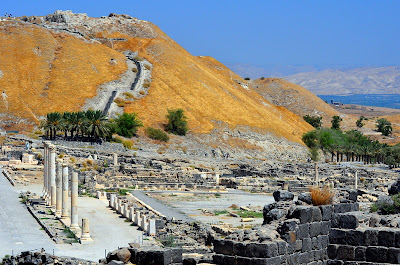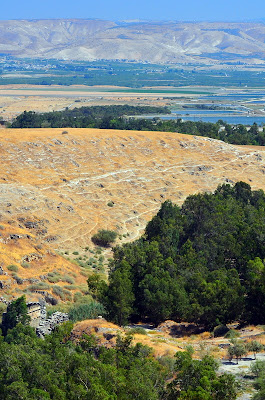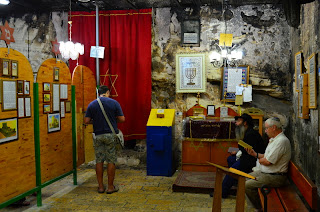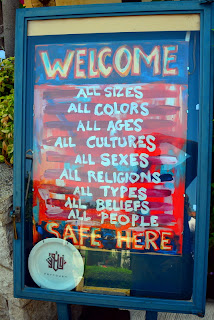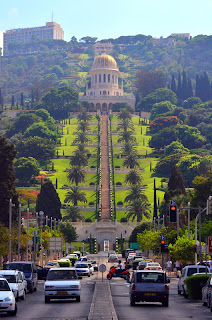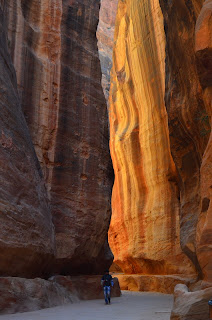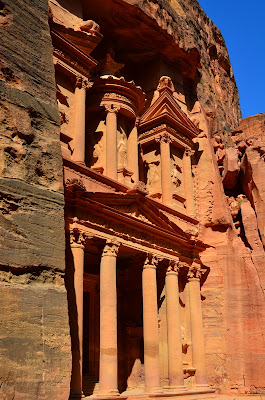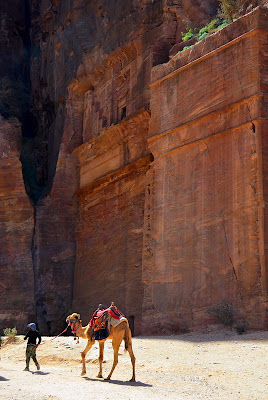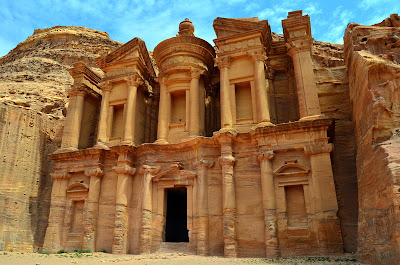Birds singing, children playing in the street, bikes whizzing by, the wind rustling in the trees, and even waves lapping on the beach--all sounds that we're only privy to hear once per year from our apartment in Tel Aviv.
Yes, today was Yom Kippur, or Day of Atonement--the holiest (and also my favorite) day of the Jewish year. And yes, due to the fact that we live above busy Hayarkon street, it is the only day of the year that we can comfortably have our apartment's windows open. Without cars, trucks, and motorbikes barreling by our building during the country-wide shutdown, it was almost shocking to experience such an array of "new" sounds.
I wrote about Yom Kippur last year, so won't go into details again (hey, that means we've been in Israel for over a year now!). The argument against Israel's especially early change back to standard time had even more backing this year, as the 2012 Yom Kippur fell almost two weeks earlier than in 2011. Religious proponents of changing Israel's clocks back to standard time 8 weeks ahead of the rest of the world cite more daylight for early morning prayers, and also seem to think that the policy encourages more Jews to participate in the Yom Kippur fast. If it was up to me, I'd side with the secularists, since I don't like getting home from work after dark unnecessarily.
According to recent polling, 64% of Israeli Jews had planned to partake in the 25 hour fast which started an hour or so prior to sunset on Yom Kippur Eve. Keep in mind that Jewish days begin at sundown based on the biblical account of creation in Genesis 1:5b, which states "And there was evening, and there was morning--the first day"). Figuring that this was our last Yom Kippur in Israel, not being pregnant (a preclusion from fasting for Jewish women), and being of age (kids who haven't had their bar/bat mitzva yet don't fast), Nicki and I decided to partake in the fast.
Our (quiet) day consisted of a lot of time on our balcony. Reading. Enjoying the view. Taking in the "new" sounds. Reflecting. Praying. Given the lack of noise, the balcony had never been so pleasant (except for YK 2011). Perhaps that's a metaphor for our relationship with God. He's there, and He wants to commune with us, but we need to get away from the "noise" in our lives.
We also went for a walk--being sure to walk right down the middle of the street, as opposed to the sidewalk, just because we could. The only potential street hazards on Yom Kippur seemed to be children on bikes and skateboards. It was funny to watch the street lights change right on schedule, though there was no car traffic to manage. We did see an ambulance and a cop car driving (slowly) around, so apparently some of the basic services don't completely shut down. Other than that, though--the whole country was at a reverent standstill. Even Ben Gurion international airport was closed.
By 6:07pm, we were ready to eat! Dinner never tasted so good. Back to work tomorrow, and then it's a four day weekend as we celebrate Sukkot (aka the Feast of Tabernacles or Feast of booths, which I wrote about last year as well).
Here is Nicki enjoying the sights and sounds from our annually-quiet balcony.
Nicki and I weren't the only ones reading...although Sammy did get to eat.
And one more - not taken on YK, but worth sharing - Sammy is excited about his new toy!
Baumers Abroad
Chronicles of the Baumers - an American family currently finding their way in Tel-Aviv, Israel

Wednesday, September 26, 2012
Wednesday, September 19, 2012
New (Jewish) Year in Bet She'an
Sounds of the Shofar being blown filled the air as we welcomed the 5723rd Jewish new year (Rosh Hashanah) while we watched the sun set from some friends' balcony. The next day, in an attempt to take advantage of the day off of work, we headed north for a quick day trip.
Having been surprised to learn that Israeli National Parks were open for visitors during the new year holiday, we decided to utilize our parks pass (on which my name is officially noted as: "James Baulmer") to visit Bet She'an National Park.
Located at the intersection of the Jezreel & Jordan valleys, Bet She'an (or Beth Shan, as it may be called in your Bible) has been inhabited for more than 5000 years. You may have read of Beth Shan in 1 Samuel 31, which details how the Philistines fastened King Saul's body to the city wall after killing him on Mount Gilboa.
Here is a picture of Bet She'an. The older ruins are up on the hill (or "tel"). In fact, 20 layers of civilizations have been found on the tel. The ruins in the foreground are from the Roman city called Scythopolis. That's Jordan in the far background.
Here is part of the refurbished Roman Theater. It held 7000 people. We learned that there were more than 8000 theaters in the Roman Empire--located all over the Mediterranean region.
Random shot. Yes, I was there.
Nicki was there, too...and it was hot!
This was taken up on the "tel". These are the super-old ruins. The hills in the background are Jordan.
This is looking east towards Jordan from the top of Tel Bet She'an. The rocky-thing in the bottom left of the picture is what remains of a large bridge from the Roman era.
This is the Roman Theater as viewed from the Tel, looking west. Those Roman columns in the foreground were set back up during modern times. Most of them had been knocked down after a large earthquake in 749 AD.
Next, we headed for the Gilboa Scenic Drive, just a few miles away. There isn't really a single "Mount Gilboa"--it's more like a ridge of small mountains. There was a lookout at the peak dubbed Mt. Shaul--this may have been where he was killed. If not, it was surely nearby. Shaul, pronounced "shah-ool", is Hebrew for Saul. I have a co-worker named Shaul.
This is the view from Mt Shaul. Bet She'an is in the very far background.
And now, switching to Sammy. He's been having a lot of fun lately. Here is is at the namal (port) fountains near our apartment in Tel Aviv.
A new favorite "toy" is the toilet (toy-let?). Flushing and dropping items into the bowl are fun pastimes.
Here he is storming the camera!
We couldn't decide which of the next two to post, so added both :) Sammy loves all things with wheels. Bikes, trains, buses, strollers, trucks, tractors--you name it.
Having been surprised to learn that Israeli National Parks were open for visitors during the new year holiday, we decided to utilize our parks pass (on which my name is officially noted as: "James Baulmer") to visit Bet She'an National Park.
Located at the intersection of the Jezreel & Jordan valleys, Bet She'an (or Beth Shan, as it may be called in your Bible) has been inhabited for more than 5000 years. You may have read of Beth Shan in 1 Samuel 31, which details how the Philistines fastened King Saul's body to the city wall after killing him on Mount Gilboa.
Here is a picture of Bet She'an. The older ruins are up on the hill (or "tel"). In fact, 20 layers of civilizations have been found on the tel. The ruins in the foreground are from the Roman city called Scythopolis. That's Jordan in the far background.
Here is part of the refurbished Roman Theater. It held 7000 people. We learned that there were more than 8000 theaters in the Roman Empire--located all over the Mediterranean region.
Nicki was there, too...and it was hot!
This was taken up on the "tel". These are the super-old ruins. The hills in the background are Jordan.
This is looking east towards Jordan from the top of Tel Bet She'an. The rocky-thing in the bottom left of the picture is what remains of a large bridge from the Roman era.
This is the Roman Theater as viewed from the Tel, looking west. Those Roman columns in the foreground were set back up during modern times. Most of them had been knocked down after a large earthquake in 749 AD.
This is the view from Mt Shaul. Bet She'an is in the very far background.
And now, switching to Sammy. He's been having a lot of fun lately. Here is is at the namal (port) fountains near our apartment in Tel Aviv.
A new favorite "toy" is the toilet (toy-let?). Flushing and dropping items into the bowl are fun pastimes.
Here he is storming the camera!
We couldn't decide which of the next two to post, so added both :) Sammy loves all things with wheels. Bikes, trains, buses, strollers, trucks, tractors--you name it.
Thursday, September 13, 2012
How to (attempt to) obtain an Israeli Driver's License
Having lived in Israel for one year, it became time for me to get an Israeli driver’s license. Yes, I’ve already been driving for a year in Israel. Yes, we only have four months until my assignment in Israel is complete. But, the law is the law—and Israeli law says that my American license is no longer valid in Israel after one year.
The process for getting a driver’s license in Israel is a bit more complex than in the States, and is in many ways a microcosm of life here. The following is a summary & timeline of the process for converting a foreign driver’s license in Israel.
Step 1: Go to your local Ministry of Transport office to get temporary id. Bring your passport. No cost.
Tips based on my experience:
· Go early, and don’t forget to grab a number as soon as you enter the office (I was #307 by 8:30 am)
· Don’t let the office worker try to tell you that you need to go to the office in Holon first; stand your ground in asking for a temporary id
· Don’t worry if they “rename” you; Both my temporary id and my national parks pass have my name listed as James Baumer (James is my middle name)
Step 2: Go to a registered photo shop to get your picture taken and to pick up the Tofes Yarok (“Green Form”). Ideally, get your eyes tested. Bring your passport and newly-acquired temporary id. Cost: 40 shekels.
Tips based on my experience:
· Choose a shop that both takes your photo AND administers the required eye test. I biked to the Dizengoff Center in central Tel Aviv and found a photo/eye shop on the first floor
· If the shopkeeper tells you you’re in the right place, but to “wait – it will take some time”, be sure that you’ve established your place in “line”--otherwise, others will wander in and get ahead of you and the shopkeeper will let you fend for yourself
· You should leave the shop with the Green Form in hand. On it will be your picture, your eye test results (on the back), and blank space for the medical exam (next step)
Step 3: See your doctor for a medical exam. Bring the Green Form. Cost: 450 shekels (private insurance) or ~100 shekels (local).
Tips based on my experience:
· Call your doctor’s cell phone – he/she will likely see you the same day
· Make sure the Dr. fills out and stamps the Green Form
Step 4: Go to the regional Ministry of Transport office for your area. Bring your completed Green Form (eye & medical exam results), passport, foreign driver’s license, temporary id, and photocopies of all of the above. Cost: none.
Tips based on my experience:
· If you live in the Tel Aviv area, the regional office is in Holon. Verify the days/hours before going. For example, Holon office is open several days a week, but only open for foreign license conversions on Sundays and Wednesdays from 7:30am to 12:30pm
· Go early! Expect to wait in a line outside the building first—given this, you may want to bring water and a hat depending on the weather
· Once inside the building, you’ll wait in line only to be told which line to wait in next, depending on your business need. Be sure to tell the office worker that you need a foreign license conversion. Unless something has changed, they “should” tell you to take a number to wait in line #8
· If they tell you to wait in any line other than 8, clarify your purpose and ask again. Then, ask again. Ask the person behind you to translate, if necessary
· Upon your number finally being called and perhaps being told that you’re in the wrong line for a foreign conversion, explain that you had simply gone where you were told. The worker may scribble something in Hebrew on a paper and tell you to take it to the front of a different line
· Don’t be surprised if those waiting in the correct line are upset if you successfully interrupt the worker at the new line and are allowed to “budge” ahead the rest of the line. Those who had been waiting in the correct line may approach you and/or approach the worker to make both of you aware of their thoughts on the matter
· You’ll leave the regional office with some additional information on your Green Form—essentially a referral to a driving instructor
Step 5: Take the Green form to your Driving Instructor’s office. Bring your Green Form. Cost: none (yet).
Tips based on my experience:
· Call ahead to make sure your driving instructor will be there to accept the form
· Choose an instructor that lives near you. You’ll go there at least twice. Mine was at xxx.
· The instructor will work with the Ministry of Transportation to schedule your driving test, and will give you a form to take to the post office, at which you’ll pay a small fee
· You’ll need to take at least one lesson (otherwise the instructor doesn’t make any money). Try to schedule it the hour prior to your actual driving test
Step 6: Take form to local Post Office to pay fee. Cost: 68 shekels
Tips based on my experience:
· In Israel, the Post Office is more multi-faceted than the typical American office. You’ll be visiting the Post Office twice during your foreign license conversion – once now, and then again later
· Take a number upon arrival, and be patient. Keep your receipt
Step 7: Take a driving lesson, then driving test. Cost: 520 shekels. Bring proof that you paid the 68 shekel fee from the Post Office.
Tips based on my experience:
· I biked to my instructor’s office, and then drove his car during the “lesson” and then to the Ministry of Transport office for the official test. You must use the instructor’s car for the lesson and test since it is specially equipped with an extra brake AND accelerator on the passenger’s side
· Even if your instructor doesn’t speak fluent English, he/she should be able to say enough key words. But if not, here is a crash course in driving-lesson-Hebrew: left (“smola”), right (“yamina”), yes (“ken”), no (“lo”)
· When taking the 3rd (left) exit on an Israeli roundabout, you are apparently supposed to turn on your left signal as you approach the roundabout. Prior to my lesson, my method would have been to circle the roundabout, then use my right turn signal prior to taking the 3rd exit
· Be sure to request an English speaking tester. And be aware that he/she may test your “chutzpah”. For example, when asked to “go around this line of cars and pass them”, don’t ask a clarifying question about whether or not to go into the left lane. Simply do it. Otherwise, the tester may respond like this: “No, pass them on their heads. What do you think? That’s it!”
· The best approach, in fact, would be not to ask any questions at all—even when you’re not clear on the command. Otherwise, for example, you might get an answer like this: “if I have to tell you everything I’ll take away your license!”
Step 8: Get your driving test results. Cost: None.
Tips based on my experience:
· Don’t expect to be told whether or not you passed or failed the test. You’ll find out your result by phone later that day. My theory was that they don’t want to give you the chance to argue with the tester. When I consulted with my co-worker on this theory, he gasped: “arguing is fine…they don’t want you to kill them!”
· Your instructor may tell you that they’ll have both your results and your papers ready for you the afternoon of your driving-test-day. This is probably not true. Call first! That way, when they tell you to come back the next day, and then again the day after that, you won’t have wasted multiple trips
· Eventually, you’ll get a paper from the driving instructor that verifies that you’ve passed your test
Step 9: Pay a fee at the post office. Bring: the paper your driver instructor gave you from step 8. Cost: 25 shekels (for 6 month foreigner’s license)
Tips based on my experience:
· You don’t have to be present. Let’s say, for example, that you need to get back to work after having taken 3 days off for steps 1-8…you’re in luck…your spouse can take care of this step
· You’ll get a paper temporary license and be told that a permanent license will be mailed. This may or may not be true for foreigners. I’ve been told by others that have gone before me that the paper is all that I’ll get, and that additional payment is required every 6 months. Since we only have four months to go, I guess I’ll never know…
After completing the process over a two week period, all I can say is “whew”. Three half-days off of work to transport paperwork between six separate locations (three of which were visited twice) sure seemed like overkill. I must say, though, that I did come away with a newfound appreciation for life in the States. It also helped me understand why at work, I’m often times the only one frustrated by what I deem as unnecessary bureaucracy. Now I get it: I’m spoiled! As one of my Israeli co-workers put it: “After I went to the US for a temporary relocation, I realized that I had been suffering in Israel!”. Well said.
Friday, August 17, 2012
Afternoon in Haifa
With the Olympics being over and our TV in dire need of a rest, we turned off the tube and headed north to Haifa for the day. Built on the slopes of Mount Carmel
(the place where Elijah challenged the followers of Baal in a cook-off as documented in 1 Kings 18), Haifa is Israel's largest port and third largest city.
Nicki, Sammy, and the Bab...
After soaking in the views, we looked forward to fueling up with some German food (bratwursts, perhaps?) in Haifa's "German Colony". Instead, we found only local-food-type-restaurants as well as an Italian one. We settled on Fattoush, an Arab-owned joint. As the sign states, it was very welcoming...which is apparently a trait that Haifa is known for, as Jews and Arabs reportedly mix in a mostly peaceful and tolerant manner.
The "colony" is really just a single street--but despite the lack of German cuisine, it does seem to have some German flair. Apparently this area was the center of a late 19th-century German Templar religious reform movement.
Here is a view looking back up at Mt Carmel and the Baha'i Gardens.
After our late lunch, Sammy was in dire need of a nap, so we headed for home. Speaking of Sammy, below are some recent pictures...
Here he is showing support for Team USA with Mom at a park near our apartment in Tel Aviv.
Notice the necklace (a new staple), and the sandals (also relatively new). Oh, and the walking! Though his first steps were a few months ago, Sammy is now walking full time. He made the transition from mostly-crawling to mostly-walking just a few days after we returned from our US (grandparents' and new cousin's houses!) trip in July.
Other new milestones, for better or worse, include climbing on the sofa and tables, turning on the oven, biting, and shoplifting (yes, he's secretly dropped candy bars into his stroller on two separate occasions--both of which his mommy later found and returned to the store).
Here's one more from the park, and that's all for now.
Our first stop was Elijah's Cave. Located at the base of Mt Carmel, this site is thought to be the cave mentioned in 1 Kings 19:9. Here is the entrance sign which is written in Hebrew (for Jews), English (for Christians), and Arabic (for Muslims)--all of whom believe the stories of Elijah. The woman who's head is shown in the bottom left (according to someone who interpreted for us, at least) wanted me to give her money because she'd thought that I'd taken her picture.
Upon entering the cave, Nicki and I needed to split up--no, not because only one of us belongs to the Khaduri Family, but rather because I am a "gever" (written in Hebrew like this: גבר, which is Hebrew for "man") and she is not.
This is what the men's side of the cave looks like (shhh...don't tell Nicki). The guys on the bench were praying (and bowing), and there were some unintelligible sounds coming from behind the curtain.
On the way out, I turned and snapped this picture of the women's side.
Rest assured, Elijah had a nice view. That's the Mediterranean Sea (with silhouette of Nicki and Sammy, of course) as viewed from the entrance of the cave.
Our next stop was the Baha'i Gardens. Perched on the slopes of Mt. Carmel, these immaculate gardens are considered "holy" ground in the Baha'i faith--of which, Haifa is apparently the world headquarters. Here's a view from atop Mt Carmel looking down at the Gardens and the city of Haifa.
And here is the same view, but looking a bit more to the east. The domed building is the "Shrine of the Bab", which is currently closed for cleaning. "Bab" was the founder of the Baha'i faith, which was founded in Iran in the 1800's and seems to be a conglomeration of all religions.
Another view of Bab's shrine, with the Haifa port in the background.
Nicki, Sammy, and the Bab...
After soaking in the views, we looked forward to fueling up with some German food (bratwursts, perhaps?) in Haifa's "German Colony". Instead, we found only local-food-type-restaurants as well as an Italian one. We settled on Fattoush, an Arab-owned joint. As the sign states, it was very welcoming...which is apparently a trait that Haifa is known for, as Jews and Arabs reportedly mix in a mostly peaceful and tolerant manner.
The "colony" is really just a single street--but despite the lack of German cuisine, it does seem to have some German flair. Apparently this area was the center of a late 19th-century German Templar religious reform movement.
Here he is showing support for Team USA with Mom at a park near our apartment in Tel Aviv.
Notice the necklace (a new staple), and the sandals (also relatively new). Oh, and the walking! Though his first steps were a few months ago, Sammy is now walking full time. He made the transition from mostly-crawling to mostly-walking just a few days after we returned from our US (grandparents' and new cousin's houses!) trip in July.
Other new milestones, for better or worse, include climbing on the sofa and tables, turning on the oven, biting, and shoplifting (yes, he's secretly dropped candy bars into his stroller on two separate occasions--both of which his mommy later found and returned to the store).
Here's one more from the park, and that's all for now.
Monday, May 7, 2012
Petra (Jordan)
Getting Sammy to sleep was a bit of a challenge. After learning that the hotel was "out" of cribs, we tried various tactics to get our little guy to bed. Three hours later, he finally passed out but then began coughing in his sleep. We seemed to have been pushing Sammy's boundaries on this trip, as he had picked up a bit of a cold.
The next morning, we woke up in and had breakfast with some fellow travellers from Germany and China. Nicki greeted the Chinese with a friendly "zao shang hao" (good morning), but it must've been too early to chat since they focused primarily on the food. After a quick meal, we were ready to head to Petra--not letting the travellers across the hall who had returned to the hotel after finding out the cost for entry to Petra dissuade us.
Here is our morning view of Wadi Musa, Jordan (the base town of Petra).
After paying the $75 per person entry fee (Q: Who travels to Jordan only to turn around due to the entrance fee to Petra, anyway? A: the guys staying across the hall from us at the inn), we were on our way. Just past the new visitor's center (still under construction), the walk into Petra begins. Here's a view of the walkway--you'll notice a path on the right for walkers, and a path on the left for horses and donkeys. We'd soon find that animal rides are a-plenty in Petra.
A Petra dwelling. Thought we were impressed by this, it turned out to be only a warm-up...
We then passed the "Obelisk Tomb". Here it is...
Soon we entered the "Siq". Al-Siq, or "the shaft" in Arabic, is a mile-long narrow gorge with soaring cliff-walls on each side. Visitors like us walk through the Siq in order to enter Petra.
Here is Nicki and Sammy in the Siq. It reminded us of "the Narrows" at Zion National Park in Utah (except there was no water).
Finally...we reached...the Treasury. Certainly Petra's most famous building, the Treasury was featured in the Indiana Jones Raiders of the Lost Ark movie. Do you remember it?
Here's the Treasury as seen from the Siq in the morning.
Many people were lining up for photos. Here's a closer look...
Here's a shot of the Treasury in its entirety...
And a side view...
After soaking in the Treasury, we moved on. This camel, standing on the "Street of Facades", was for hire...
Petra (Greek for "rock") was established as the Nabataean capital somewhere around the 6th century, BC. Before that, though, the area was apparently inhabited by the Edomites (descendants of Esau). Here's a link to some information regarding Petra in the Bible, if you're interested.
This is the Petra Theater. With a capacity of 6000 people, it was apparently constructed during the 1st century AD.
Next, we headed to the Monastery. Some local donkey-owners lied to us about the length of the climb. Between the unknown distance to the monastery, and the fact that we were carrying Sammy, we decided to cave in and opted for the donkey ride. We got a "special price" for being Americans, after all (yeah right).
It turned out to be fun, if not a bit nerve racking in some areas with steep climbs and no handrails. Here is Nicki (and Sammy) with their trusty donkey at the Monastery.
Quite a site. Here's the monastery. Note how dwarfed the people look (yes, it's huge!).
By afternoon, the amount of tourists had at least doubled. Many of the day-tours from Eilat (Israel) had arrived. We were glad to be on a "self-guided" tour...
Many cab drivers were waiting for tourists on the way out of Petra. We tried to ride with the same guy who'd brought us to Wadi Musa the previous day--but after an internal driver argument, another guy won our business. The ride back to Eilat was 35 Dinar, whereas the ride from Eilat to Petra had been 65 Dinar. We had read in advance that a "taxi mafia" controlled the price from the border with Israel, so we had given up on bargaining.
Here's a shot out the cab window on the ride back to the Arava Crossing (border of Jordan/Israel near Eilat). Wadi Rum is in the background somewhere.
Another out-the-window shot. These camels seemed to be roaming wild.
Finally, we were back at the border--with our car waiting. Our fascinating self-guided trip to the Hashemite Kingdom of Jordan was complete.
Subscribe to:
Comments (Atom)



